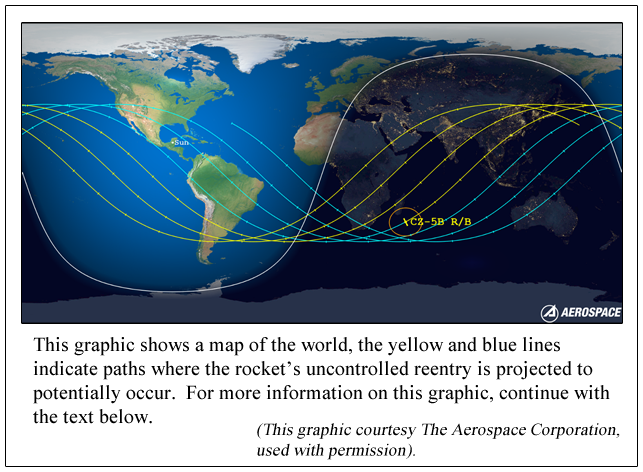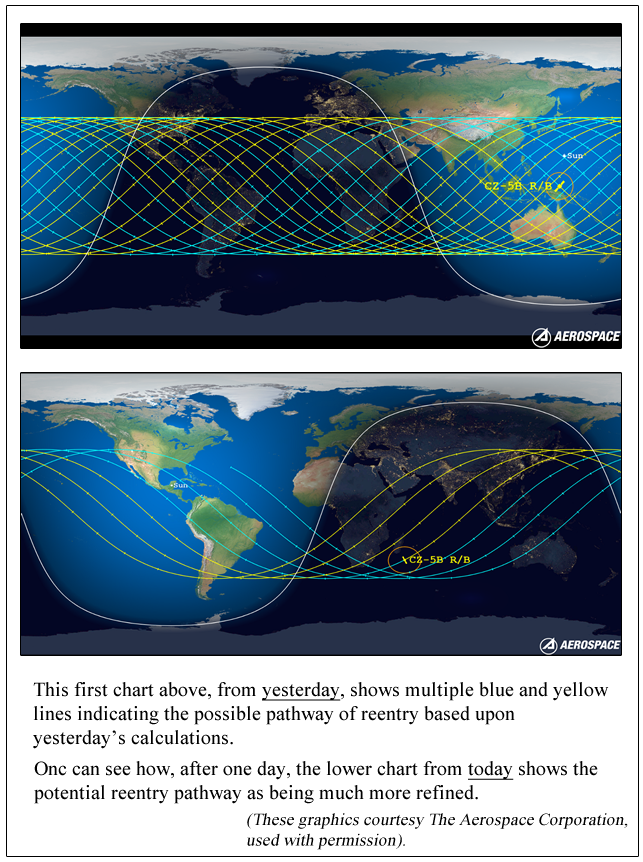|
Many in our Boundary County / Pacific Northwest
region are aware that space experts are closely
monitoring a spent rocket booster stage that is
wobbling out of its current orbit and will soon
be falling back to earth in an uncontrolled
reentry.
This rocket stage is huge.
With its height about the same as a
16-story building, and weight of about 25 tons,
it is the sixth largest space equipment object
to ever reenter.
When will it reenter the atmosphere and crash
back to earth?
The experts’ latest calculations say:
Tomorrow.
That would be tomorrow, Saturday, July
30.
And they even have a time for you:
the current projection is for reentry to
occur at 11:05 am Boundary County time, plus or
minus five hours.
All of this information is provided by the
experts at the Center for Orbital and Reentry
Debris Studies (CORDS), which is a division of
The Aerospace Corporation, a federally-funded
nonprofit research and development center that
focuses exclusively on the enterprises of space,
and spans all disciplines of space-related
science and engineering.
Keep in mind that because of the uncontrolled
nature of this reentry, the estimates of the
time, and location, of reentry are continuously
changing—but gradually becoming more
refined—over time.
This uncontrolled reentry does not have a
defined and clearly predictable reentry path.
However, using the data available, the
experts at CORDS are able to make some very
useful predictions, and some pathway
calculations, which they are constantly fine
tuning with new data and observations.
Getting to the questions that are foremost in
everyone’s thinking:
• Where will reentry occur?
• Will there be dangerous space debris crashing
to earth with this reentry?
• How did this happen?
ANSWERING THE FIRST QUESTION:
Where will reentry occur?
To answer the first question, thanks to the
experts at CORDS and The Aerospace Corporation,
we can safely say that reentry will most likely
not occur over Boundary County, nor over the
Pacific Northwest, for that matter.
CORDS has calculated an entry window for this
rocket stage.
The window as it is currently calculated
is in the shape of a belt that wraps around the
central and southern surfaces of the earth.
This is a wavy belt shape.
The following chart gives a visual idea
of where the reentry point could occur.
See the text below the picture for more
of an explanation.
(Story continues below this
graphic. To see a larger version of this
graphic,
click here).

At this time, according to the most recent data
provided by CORDS, the falling rocket stage
could reenter at any point along the yellow or
blue waving lines drawn on this map of the
world.
The orange circle with the yellow text
attached to it simply marks the center spot of
this predicted reentry pathway.
Note that the dark / light areas of the
map with the white line border show what parts
of the earth will be in daylight or nighttime at
the projected time of reentry.
CORDS says that reentry is NOT expected to occur
at a point outside of the marked blue or yellow
paths.
Thus, as one can observe on the map
graphic, our area and the rest of the Pacific
Northwest is not expected to be endangered
directly by this uncontrolled reentry.
Unfortunately, many populated land areas
of the world are directly within the projected
reentry pathway.
As mentioned above, as the time of reentry draws
closer, the expected pathway of reentry can
gradually be more clearly defined.
This can be illustrated by comparing
(below) the chart released yesterday with
yesterday’s predictions for the projected
reentry pathway, with the more highly refined
and precise projected pathway that was released
today, showing the projections honed to a more
specific path.
(Story continues below this
graphic)

One can see that over time, since yesterday, the
potential path for reentry of this renegade
rocket stage has been been trimmed
substantially.
As hours pass, CORDS will be able to
increasingly pinpoint the most likely reentry
areas.
ANSWERING THE SECOND QUESTION:
Will there be dangerous space debris
crashing to earth with this reentry?
The short answer is:
Most likely, yes.
We all know that when objects enter
earth’s atmosphere, most of the time those
objects burn up.
However, with very large objects, like
this 25-ton rocket stage, its massive size is
too large for the object to completely burn up
on passing through the atmosphere.
According to Space Debris expert Marlon Sorge, a
technical fellow for the Space Innovation
Directorate of The Aerospace Corporation, “The
general rule of thumb is that 20–40% of the mass
of a large object will reach the ground, but the
exact number depends on the design of the
object. In this case, we would expect about five
to nine metric tons.”
We will do the math for you.
Five to nine metric tons is equal to
about 5.5 to 9.9 regular tons.
Where will these tons of debris strike?
They can’t exactly say.
According to the CORDS experts:
“The spread of debris, referred to as the
“debris footprint,” is not something experts can
speculate on at this time, given the degree of
uncertainty remaining for the reentry point.
However, any spot away from the lines [on the
chart above] are very unlikely to be at risk
from debris.”
Calling your attention to the last sentence of
that quotation just given, our area is also very
unlikely, based upon these calculations, to see
any of the debris from the breaking and burning
of the rocket stage on its uncontrolled reentry.
However, again many populated areas of
the world are within the area at higher risk for
those 5.5 to 9.9 tons of debris to fall,
according to the chart above.
ANSWERING THE FINAL, THIRD QUESTION:
How did this happen?
The rocket stage that is now in uncontrolled
reentry to earth is a stage from a Chinese
launch that occurred less than a week ago, last
Sunday, July 24.
China is currently working on a longterm
process of assembling an orbiting space station,
the Tiangong Space Station.
Last Sunday, as part of their space station
program, China launched one of their Long March
5B rockets to deliver the Wentian experiment
module to their space station.
“The Long March 5B reentry is unusual,”
according to the experts at CORDS, “because
during launch, the first stage of the rocket
reached orbital velocity instead of falling
downrange as is common practice. The empty
rocket body is now in an elliptical orbit around
Earth where it is being dragged toward an
uncontrolled reentry.”
This is not the first time an uncontrolled
reentry crash has resulted from China’s space
station assembly program.
On April 29, 2021, when China launched
the first module of their Tiangong space
station, again using a Long March 5B rocket,
that rocket body also traveled into orbit
instead of falling downrange into the sea, a
situation almost exactly like we have today.
That rocket stage back in April 2021 also
ended up in an uncontrolled reentry.
According to CORDS, “[The uncontrolled
2021] rocket’s path crossed several populated
areas and captured the world’s attention before
eventually landing in the Indian Ocean near the
Maldives on May 8.”
Today, we now deal with the crashing reentry of
China’s booster rocket for the second module of
its under-construction space station.
We are fortunate that our region appears at this
point to be safe from the reentry of the falling
rocket stage, and from tons of crashing debris.
However other areas of the world remain
in potential danger.
According to The Aerospace Corporation
and their CORDS division, we should know the
results of this uncontrolled large rocket stage
reentry within the next 24 hours or so.
|

